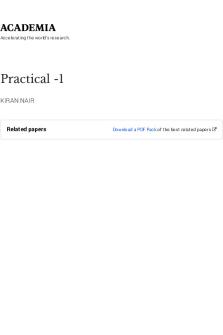Protocols Practical 1 - Andrew Secure RPC PDF

| Title | Protocols Practical 1 - Andrew Secure RPC |
|---|---|
| Author | Vasilka Zheleva |
| Course | Identity, Trust, Reputation & Their Applications |
| Institution | University of York |
| Pages | 1 |
| File Size | 38.2 KB |
| File Type | |
| Total Downloads | 89 |
| Total Views | 127 |
Summary
exercises...
Description
1
Security Protocols and BAN Logic ITRA Practical Session
P RACTICAL 1: A NDREW S ECURE RPC P ROTOCOL An early version of the Andrew Secure Remote Procedure Call (RPC) Protocol uses an authentication handshake between two principals whenever a client binds to a new server [1]. ′ The handshake is intended to allow a client A to obtain a new session key Kab from a server
B, given that they already share a key Kab . The protocol in standard notation is as follows: Message 1.
A → B : A, {Na}Kab
Message 2.
B → A : {Na + 1, Nb }Kab
Message 3.
A → B : {Nb + 1}Kab
Message 4.
′ , Nb′}Kab B → A : {Kab
where Na, Nb , and Nb′ are nonces. Nb′ is to be used in subsequent communication. In this exercise you will use BAN logic to analyse the protocol. Task 1: Idealise the protocol. Task 2: State the initial assumptions. Task 3: Express protocol goals in BAN logic and perform protocol analysis. Can you identify a weakness of the protocol? Task 4: Demonstrate an attack on the protocol. Can you fix it? Can you suggest an even better improvement that would reduce the total encryption needed? R EFERENCES [1] M. Satyanarayanan, “Integrating security in a large distributed system,” ACM Transactions on Computer Systems, vol. 7, no. 3, 1989, pp. 247-280. [2] M. Burrows, M. Abadi, and R. M. Needham, “A logic of authentication,” ACM Transactions on Computer Systems, vol. 8, no. 1, 1990, pp. 18-36....
Similar Free PDFs

Practical -1
- 20 Pages

Pre-action protocols
- 1 Pages

RPC Table OF Elements - Summary
- 47 Pages

Transparent RPC mechanism
- 2 Pages

Lab practical 1
- 5 Pages

Chemistry Practical 1
- 4 Pages

How secure is the cloud
- 1 Pages

Practical Research 1
- 14 Pages
Popular Institutions
- Tinajero National High School - Annex
- Politeknik Caltex Riau
- Yokohama City University
- SGT University
- University of Al-Qadisiyah
- Divine Word College of Vigan
- Techniek College Rotterdam
- Universidade de Santiago
- Universiti Teknologi MARA Cawangan Johor Kampus Pasir Gudang
- Poltekkes Kemenkes Yogyakarta
- Baguio City National High School
- Colegio san marcos
- preparatoria uno
- Centro de Bachillerato Tecnológico Industrial y de Servicios No. 107
- Dalian Maritime University
- Quang Trung Secondary School
- Colegio Tecnológico en Informática
- Corporación Regional de Educación Superior
- Grupo CEDVA
- Dar Al Uloom University
- Centro de Estudios Preuniversitarios de la Universidad Nacional de Ingeniería
- 上智大学
- Aakash International School, Nuna Majara
- San Felipe Neri Catholic School
- Kang Chiao International School - New Taipei City
- Misamis Occidental National High School
- Institución Educativa Escuela Normal Juan Ladrilleros
- Kolehiyo ng Pantukan
- Batanes State College
- Instituto Continental
- Sekolah Menengah Kejuruan Kesehatan Kaltara (Tarakan)
- Colegio de La Inmaculada Concepcion - Cebu







